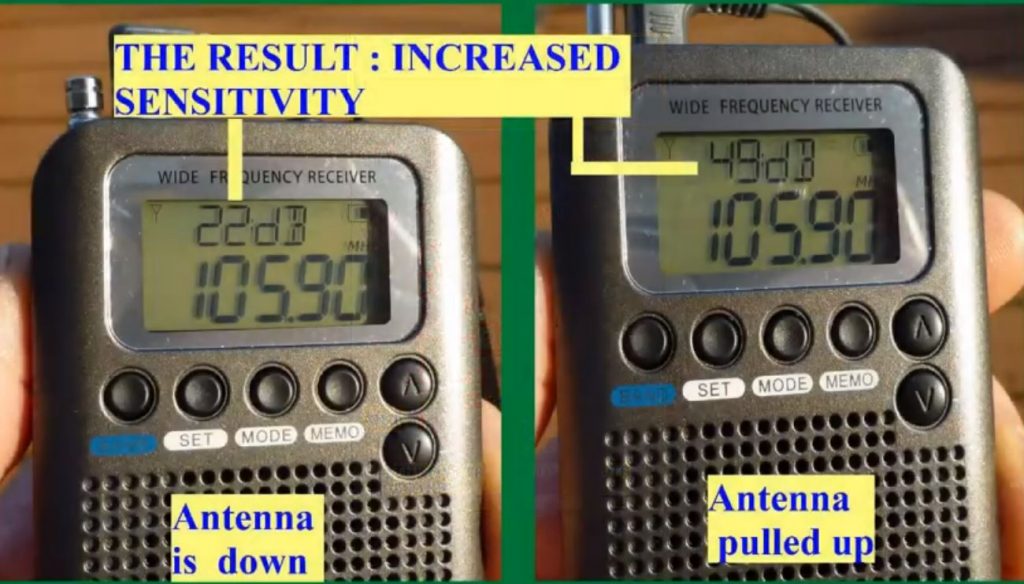Many thanks to SWLing Post contributor, Imre Olajos, who writes:
Hi, HRD 737 lovers! I have a good news!
I (became brave enough to) modify my HRD-737.
I tried reverse-engineering- but I gave up. No numbers on IC-s. I found specifications for the analog switches (one for each band ) and found information about the transistors around those analog switch IC-s. Nice, 1 GHz fT transistors, all surface mount, so I gave up that line.
I found an NPN SM transistor in a damaged TV remote. It is only a 300 MHz transistor but
I had no better than that, so I started to build a little antenna amplifier circuit, wide band and simple.I lost a few SM capacitors during the soldering but I have plenty of those. So the 1/4 square inch circuit board was finished last week. I tested it with an external 3 volt battery and I found it good working. Today ( 07-27-2019 ) I opened up the HRD-737 and wired it into the radio.
The results are much better than I expected. The HDR-737 became a good shortwave radio!When I touch the built in antenna by my finger, radio is sensing the touch and station comes in. This effect was not there before. Radio became more sensitive on CB band than my Realistic DX392.
I have a YouTube channel [in the following video/slideshow] and I will show you the little ugly but great working circuit in the radio:
Click here to view on YouTube.
Later on next week I will try to record some video of the shortwave reception and post up it on the same YouTube channel.
I am a shortwave lover since 50+ years and I will be very happy to share the good news with others. Now I can listen my Greek music on this little radio, on 9420 kHz. Yes, the radio became [more sensitive than I had hoped].
You can see my other shortwave radios on my YouTube channel too, Have fun and never give up the hope!
Many thanks, Imre, for sharing and documenting this modification. One of the lessons here, too, is that if you have an inexpensive radio like the HanRongDa HRD-737 and you feel tempted to try a modification, there’s little to lose. It’s not like modifying a $1000 transceiver–just dig into the little radio and give it a go. If you harm the radio, you’ve only invested $37 or so in the project. That’s a much better solution than letting it sit on a shelf collecting dust because it’s not sensitive enough! Well played, Imre!


In my opinion this receiver is intended to be used in country areas, in places with low level of electrical noise or far from strong electromagnetic fields. I live in a central area of a big city, with many TVs and FM stations, so I never heard any station in the HF band. In fact, until now, I don’ t know if the radio is really working well in this band.
The receiver works fine in the FM and AM bands, because the power emited by theese kind of stations is very high. I heard one strong station in VHF band. Never heard anything in AIR and CB bands.
The digital controls are amazing, and show a good performance.
This receiver is broad band and need input filters and more sensitivity. The telescopic antenna is too weak and has bad performance. We payed for a multiband receiver that only works well in AM and FM bands.
Where is +20 dB to him?
Even without any improvement in sensitivity, this receiver accepts a huge number of side channels. In the aviation range, this receiver already has 2 stages of radio frequency amplification. And some side channels of reception in terms of strength of reception do not differ from the main ones. From an additional amplifier, nothing but terrible chaos will come out. Waste of time.
The phrase amused that reengineering is difficult as it is not clear what chip is used. It’s clear that AKC6955 is used in this radio.
http://maximradio.altervista.org/akc6955/AKC6955-datasheet-english.pdf
http://www.radioscanner.ru/uploader/2019/hrd737-inside1.jpg
According to the previous review published on SWLing, here
https://swling.com/blog/2019/01/critical-reviews-of-the-37-hanrongda-hrd-737-shortwave-radio/
the receiver seems to be pretty noisy and prone to overloading, and I doubt that adding an antenna preamp would cure it (especially the overloading bit), sure, you’ll have more noise, but will that be an advantage 🙂 ?